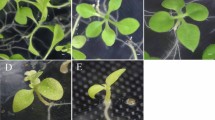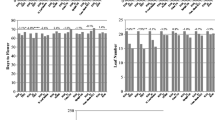Abstract
To elucidate the genetic mechanism of hybrid lethality observed in hybrids between cultivated tobacco, Nicotiana tabacum, and wild tobacco species in the section Suaveolentes, genetic analyses were conducted through the triple cross of the hybrids of wild species, including N. benthamiana and N. fragrans, and N. tabacum. N. benthamiana and N. fragrans produced only viable hybrids after crossing with N. tabacum. Subsequently, N. benthamiana and N. fragrans were crossed with N. africana, N. debneyi, and/or N. suaveolens, which produced inviable hybrids after crossing with N. tabacum. Hybrids of the wild species were obtained from four of the six cross combinations. Only when hybrid plants of N. debneyi × N. fragrans, whose hybridity was confirmed by morphological characteristics, random amplified polymorphic DNA analysis, and chromosome observation, were crossed with N. tabacum, triple hybrids were obtained and segregated 1:1 (lethal:viable). Based on these results, a single dominant gene, designated Hybrid Lethality A1 (HLA1), in N. debneyi was found to control hybrid lethality by the interaction with gene(s) on the Q chromosome in N. tabacum. This represents the first report to identify a causal gene for hybrid lethality in the genus Nicotiana.



Similar content being viewed by others
References
Bomblies K, Lempe J, Epple P, Warthmann N, Lanz C, Dangl JL, Weigle D (2007) Autoimmune response as a mechanism for a Dobzhansky–Muller type incompatibility syndrome in plants. PLoS Biol 5:e236
Chase MW, Knapp S, Cox AV, Clarkson JJ, Butsko Y, Joseph J, Savolainen V, Parokonny AS (2003) Molecular systematics, GISH and the origin of hybrid taxa in Nicotiana (Solanaceae). Ann Bot 92:107–127
Clarkson JJ, Knapp S, Garcia VF, Olmstead RG, Leitch AR, Chase MW (2004) Phylogenetic relationships in Nicotiana (Solanaceae) inferred from multiple plastid DNA region. Mol Phylogenet Evol 33:75–90
Clarkson JJ, Kelly LJ, Leitch AR, Knapp S, Chase MW (2010) Nuclear glutamine synthetase evolution in Nicotiana: phylogenetics and the origin of allotetraploid and homoploid (diploid) hybrids. Mol Phylogenet Evol 55:99–112
Comai L (2000) Genetic and epigenetic interaction in allopolyploid plants. Plant Mol Biol 43:387–399
Coyne JA, Orr HA (2004) Speciation. Sinauer Associates, Sunderland
DeVerna JW, Myers JR, Collins GB (1987) Bypassing prefertilization barriers to hybridization in Nicotiana using in vitro pollination and fertilization. Theor Appl Genet 73:665–671
Gerstel DU, Burns JA, Burk LG (1979) Interspecific hybridization with an African tobacco, Nicotiana africana Merxm. J Hered 70:342–344
Ichitani K, Namigoshi K, Sato M, Taura S, Aoki M, Matsumoto Y, Saitou T, Marubashi W, Kuboyama T (2007) Fine mapping and allelic dosage effect of Hwc1, a complementary hybrid weakness gene in rice. Theor Appl Genet 114:1407–1415
Jeuken MJW, Zhang NW, McHale LK, Pelgrom K, den Boer E, Lindhout P, Michelmore RW, Visser RGF, Niks RE (2009) Rin4 causes hybrid necrosis and race-specific resistance in an interspecific lettuce hybrid. Plant Cell 21:3368–3378
Kobori S, Marubashi W (2004) Programmed cell death detected in interspecific hybrids of Nicotiana repanda × N. tomentosiformis expressing hybrid lethality. Breed Sci 54:347–350
Kuboyama T, Sato T, Matsumoto T, Wu J, Kanamori H, Taura S, Sato M, Marubashi W, Ichitani K (2009) Fine mapping of HWC2, a complementary hybrid weakness gene, and haplotype analysis around the locus in rice. Rice 2:93–103
Ladiges PY, Marks CE, Nelson G (2011) Biogeography of Nicotiana section Suaveolentes (Solanaceae) reveals geographical tracks in arid Australia. J Biogeogr 38:2066–2077
Mizuno N, Hosogi N, Park P, Takumi S (2010) Hypersensitive response-like reaction is associated with hybrid necrosis in interspecific crosses between tetraploid wheat and Aegilops tauschii Coss. PLoS One 5:e11326
Murashige T, Skoog F (1962) A revised medium for rapid growth and bio assays with tobacco tissue cultures. Physiol Plant 15:473–497
Murray MG, Thompson WF (1980) Rapid isolation of high molecular weight plant DNA. Nucleic Acids Res 8:4321–4325
Reed SM, Collins GB (1978) Interspecific hybrids in Nicotiana through in vitro culture of fertilized ovules. J Hered 69:311–315
Song L, Guo W, Zhang T (2009) Interaction of novel Dobzhansky–Muller type genes for the induction of hybrid lethality between Gossypium hirsutum and G. barbadense cv. Coastland R4–4. Theor Appl Genet 119:33–41
Tezuka T, Marubashi W (2004) Apoptotic cell death observed during the expression of hybrid lethality in interspecific hybrids between Nicotiana tabacum and N. suaveolens. Breed Sci 54:59–66
Tezuka T, Marubashi W (2006a) Hybrid lethality in interspecific hybrids between Nicotiana tabacum and N. suaveolens: evidence that the Q chromosome causes hybrid lethality based on Q-chromosome-specific DNA markers. Theor Appl Genet 112:1172–1178
Tezuka T, Marubashi W (2006b) Genomic factors lead to programmed cell death during hybrid lethality in interspecific hybrids between Nicotiana tabacum and N. debneyi. SABRAO J Breed Genet 38:69–81
Tezuka T, Kuboyama T, Matsuda T, Marubashi W (2007) Possible involvement of genes on the Q chromosome of Nicotiana tabacum in expression of hybrid lethality and programmed cell death during interspecific hybridization to N. debneyi. Planta 226:753–764
Tezuka T, Kuboyama T, Matsuda T, Marubashi W (2010) Seven of eight species in Nicotiana section Suaveolentes have common factors leading to hybrid lethality in crosses with Nicotiana tabacum. Ann Bot 106:267–276
Wheeler HM (1945) A contribution to the cytology of the Australian-South Pacific species of Nicotiana. Proc Natl Acad Sci USA 31:177–185
Williams JGK, Kubelik AR, Livak KJ, Rafalski JA, Tingey SV (1990) DNA polymorphisms amplified by arbitrary primers are useful as genetic markers. Nucleic Acids Res 18:6531–6535
Yamada T, Marubashi W, Niwa M (1999) Detection of four lethality types in interspecific crosses among Nicotiana species through the use of three rescue methods for lethality. Breed Sci 49:203–210
Acknowledgments
We thank Japan Tobacco, Inc., Iwata, Japan, for providing seeds of cultivated and wild species of the genus Nicotiana. This work was partly supported by a Grant-in-Aid for Young Scientists (Start-up; No. 20880024) from the Japan Society for the Promotion of Science, Japan.
Author information
Authors and Affiliations
Corresponding author
Rights and permissions
About this article
Cite this article
Iizuka, T., Kuboyama, T., Marubashi, W. et al. Nicotiana debneyi has a single dominant gene causing hybrid lethality in crosses with N. tabacum . Euphytica 186, 321–328 (2012). https://doi.org/10.1007/s10681-011-0570-3
Received:
Accepted:
Published:
Issue Date:
DOI: https://doi.org/10.1007/s10681-011-0570-3




